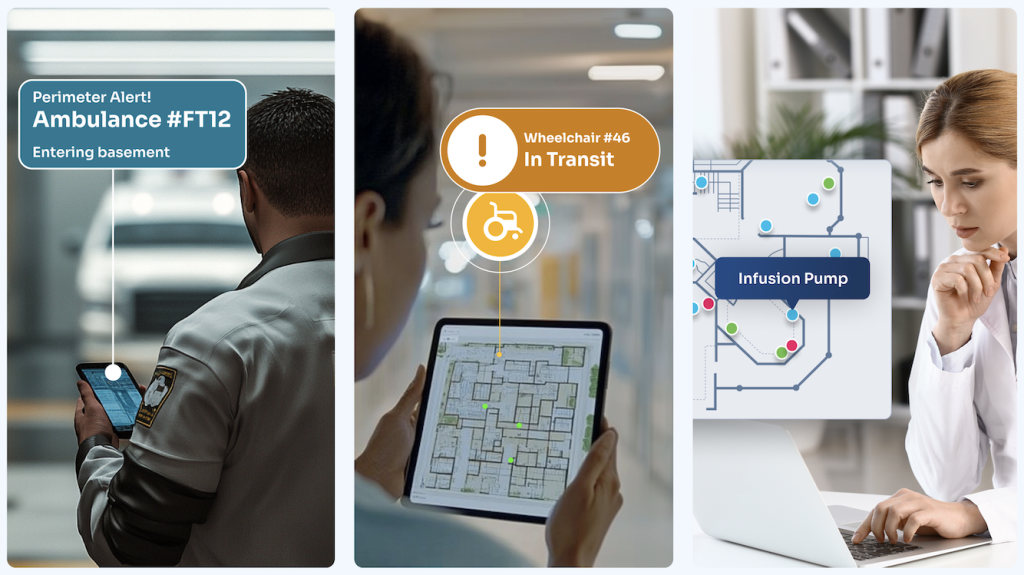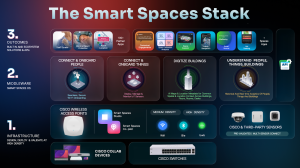
Efficient asset management is crucial for businesses aiming to streamline operations and reduce costs. Discover nine key benefits of asset tracking systems – such as improved efficiency, security and planning – that empower smarter and more effective operations.
What Is An Asset Tracking System & How Does It Work?
An asset tracking system is a solution that monitors the location, status, and usage of physical assets using technologies such as Bluetooth Low Energy (BLE), Radio Frequency Identification (RFID), Global Positioning System (GPS), or Wi-Fi. These systems employ hardware components like tags or sensors, which are attached to the assets, as well as software components like dashboards or tracking platforms that provide real-time data and insights. Communication networks, often leveraging existing IT infrastructure, ensure seamless data transfer from the asset tags to the tracking software, allowing users to monitor assets remotely.
By automating the monitoring and management of physical assets, asset tracking systems eliminate time-consuming manual processes such as locating lost items or conducting manual inventories, which can significantly slow down operations. With enhanced asset visibility, companies can ensure higher equipment availability, reduce downtime, and maintain workflow consistency, ultimately leading to more efficient and cost-effective operations.
9 Key Benefits of Asset Tracking Systems for Smarter Operations
Asset tracking systems bring significant advantages to organizations by streamlining workflows, enhancing security, cutting costs, and improving decision-making. Through the integration of technologies like BLE, RFID, GPS, or Wi-Fi, these systems empower businesses to monitor and manage their physical assets efficiently, reducing delays and increasing operational visibility. Below are nine key benefits outlining how asset tracking systems impact smarter operations.
1. Improves Organizational Efficiency
Faster Search & Retrieval
Real-time tracking eliminates the frustration and wasted time associated with locating lost or misplaced equipment. With asset tracking systems, teams can instantly pinpoint an asset’s exact location, allowing faster access to tools, machinery, or devices when needed. This feature is especially beneficial for departments that work collaboratively and share equipment, such as IT teams, healthcare providers, and manufacturing units.
Additionally, this improved efficiency reduces delays in project start times or service delivery — ensuring smoother workflows and meeting tight deadlines. Whether it’s a hospital seeking critical medical equipment or an IT team locating shared laptops, faster retrieval ensures operations stay on track.
Proactive Inventory Adjustments
Asset tracking systems enable teams to monitor real-time data on asset availability, allowing them to identify surpluses or shortages ahead of time. This proactive strategy prevents over-ordering unnecessary equipment or missing replenishment schedules for vital tools and devices. Managing inventory for tool rooms, field equipment, or shared resources becomes more streamlined and cost-effective. By avoiding stock shortages and unnecessary excesses, organizations can maintain balanced inventory levels to meet ongoing operational demands.
2. Cuts Costs & Optimizes Maintenance
Reduced Downtime
Tracking systems help teams quickly locate assets and assess their condition, reducing downtime caused by broken or unavailable equipment. Faulty tools or machinery can be flagged for repair or reallocated efficiently, ensuring continuity in services without major interruptions.
Lost productivity due to asset unavailability or prolonged repair times is minimized, leading to quicker project completion and enhanced service delivery. Whether it’s addressing equipment malfunctions or redistributing resources between departments, the ability to respond promptly drastically improves operational cost-efficiency.
Preventive Maintenance Scheduling
Preventive maintenance becomes more manageable with asset tracking systems, as they can support scheduled inspections to ensure assets remain in optimal condition. Alerts based on time intervals or usage data enable teams to perform maintenance before equipment failures occur.
Emergency repairs can be reduced, asset lifespans lengthened, and repair budgets optimized through better planning and proactive measures. This type of preventive approach not only saves money but enhances the overall reliability of critical assets.
3. Improves Security & Prevents Loss
Instant Alerts For Unusual Movement
Asset tracking systems enhance security by detecting unexpected activity or unauthorized movement of assets. Automatic alerts can be sent to IT or security teams for immediate action, helping protect sensitive or high-value items like medical equipment, servers, or specialized tools.
With real-time notifications, organizations can mitigate risks like theft or unapproved usage, ensuring their valuable assets remain secure and accounted for at all times.
Geo-Fencing High Value Areas
Geo-fencing technology allows organizations to create virtual boundaries for restricted spaces, such as server rooms, laboratory areas, or secure storage units. Asset tracking systems trigger alerts whenever assets leave or enter these designated zones. This not only prevents unauthorized or accidental removal of assets but also strengthens compliance with security policies. Such measures are vital in industries that handle sensitive data or operate with expensive machinery.
4. Simplifies Compliance & Audits
Automated Documentation
With asset tracking systems, organizations can automate the documentation of asset movements, usage patterns, and handoffs. This eliminates the need for manual record-keeping, saving time and improving accuracy.
Having a verifiable audit trail ensures organizations can quickly provide inspectors or auditors with comprehensive reports during compliance reviews or industry certifications, reducing stress during regulatory assessments.
Regulatory Audits Made Easier
Centralized asset records make preparing for audits significantly simpler. With all data stored and easily retrievable, organizations can quickly demonstrate compliance with industry-specific standards in IT, healthcare, manufacturing, or other regulated fields.
Asset tracking systems provide detailed logs of location, condition, and custody history, ensuring transparency and simplifying the process of meeting legal or regulatory obligations.
5. Increases Staff Productivity & Accountability
Streamlined Check-In Check-Out
Digital check-in and check-out processes save time and reduce confusion when multiple employees share important tools or devices. Whether it’s tracking laptops, mobile devices, or medical equipment, organizations can easily manage their shared resources.
This streamlined process reduces asset hoarding or accidental loss, ensuring that every asset is accounted for, available for use, and in the right hands.
Employee Performance Metrics
Asset tracking systems provide usage data that can be linked to employee responsibilities, helping organizations evaluate workflows and measure employee performance more effectively. These insights can highlight areas for process improvement or reveal training gaps that need addressing.
When asset usage is transparent, accountability improves, fostering better resource management and efficient task execution across teams.
6. Extend the Life of Your Assets
Proactive Maintenance & Timely Repairs
Monitoring data from asset tracking systems allows organizations to carry out timely repairs and scheduled maintenance, reducing wear and tear. This helps extend the lifecycle of assets, ensuring their long-term functionality and reliability.
Avoid Overuse & Misuse of Equipment
Tracking usage patterns ensures that equipment is not overused or misused, preventing premature breakdowns. By balancing deployment and understanding utilization rates, businesses can optimize asset management and avoid unnecessary replacements.
7. Keep Track of Key Documentation
Centralized Access to Warranties, Licenses, & Contracts
Asset tracking systems often include features for storing related documentation, such as warranties, licenses, and contracts. This centralized access helps organizations retrieve critical information quickly during audits, renewals, or maintenance scheduling.
Improved Compliance & Audit Readiness
By tying documentation directly to specific assets, organizations further improve compliance processes and eliminate the risks of losing important paperwork. Such systems ensure smooth audits and adherence to legal and industry standards.
8. Enables Real-Time Decision-Making
Know Where Every Asset Is, In Real Time
Real-time tracking systems provide immediate visibility into asset location and availability, enabling quicker troubleshooting and resource reallocation. This prevents disruptions and keeps workflows consistent, even during unexpected changes or demands.
Gain Insight Into Asset Utilization Trends
The data collected from asset tracking systems can be analyzed to identify utilization trends, forecast demand, and guide procurement decisions. Teams gain critical insights that help them adapt strategies and optimize operations based on evolving needs.
9. Simplifies Asset Oversight & Planning
Eliminate Manual Tracking & Spreadsheets
Asset tracking systems automate traditionally time-consuming processes and reduce reliance on manual tracking methods like spreadsheets. This ensures greater accuracy while eliminating administrative burdens tied to asset management.
Support Smarter Procurement & Planning
With deeper visibility into asset usage and condition, organizations can make better decisions on upgrades, replacements, and budgeting. Data-driven insights help teams optimize procurement plans and prepare strategically for future operational needs.
Key Features of a Scalable, Infrastructure-Friendly Asset Tracking System
Cloud access & reporting
Cloud-based platforms empower organizations with the flexibility to track and manage assets from anywhere in the world. These systems provide real-time dashboards, detailed reporting, and automated alerts, enabling teams located across multiple locations to have centralized control and data visibility. Whether monitoring asset movement, condition, or usage, cloud accessibility bridges gaps between distributed facilities, leading to improved coordination and faster decision-making.
With solutions like Cisco Spaces, businesses gain access to dashboards powered by real-time telemetry for comprehensive asset visibility. The scalable cloud-based system ensures that organizations obtain actionable insights, which are accessible from any device—maximizing convenience and operational efficiency.
Scalable hardware options
A truly scalable asset tracking system supports diverse tagging technologies, such as Bluetooth Low Energy (BLE), RFID, and QR codes, catering to different types of assets and use cases. This flexibility ensures that businesses can track tools, equipment, or devices without overhauling their infrastructure as needs evolve. Scalable solutions grow alongside the organization, accommodating more assets and users while avoiding significant hardware replacement costs.
Cisco Spaces delivers compelling scalability by working with over 50 BLE vendors and seamlessly adapting to existing hardware configurations. Without requiring proprietary equipment, this system enables businesses to achieve cost-efficient growth while ensuring compatibility across asset-tracking devices. In addition to this, Cisco Spaces enables Asset Tracking using existing Cisco network hardware, making it a highly scalable option, too.
Integration with existing platforms
Strong integration with established platforms such as IT Service Management (ITSM), Enterprise Resource Planning (ERP), and security systems can greatly enhance asset tracking effectiveness while minimizing operational disruptions. Such integration minimizes workflow disruptions by leveraging the organization’s current infrastructure, ensuring faster adoption and improved functionality. Compatibility with existing systems reduces operational complexity while adding value to current processes, including data management, inventory tracking, and process automation.
Cisco Spaces integrates natively with Meraki and Catalyst platforms, offering a streamlined deployment experience that doesn’t demand additional investments in standalone infrastructure. This integration reduces overall costs while enhancing the efficiency of operations by aligning asset tracking with broader IT and security workflows.
Accelerate Your Journey To Intelligent Workflows with Cisco Spaces
Harnessing real-time visibility, automation, and actionable data insights, Cisco Spaces empowers organizations to reduce loss, streamline workflows, and make smarter operational decisions. By providing instant access to asset location and usage data, teams can resolve inefficiencies, minimize downtime, and focus on high-value tasks. Whether you’re managing IT assets across multiple offices or equipment in complex healthcare facilities, Cisco Spaces ensures proactive decision-making, reducing risks and optimizing processes for productivity and seamless operations.
Effective asset tracking is essential for achieving goals like cost control, minimizing asset downtime, enhancing staff productivity, and maintaining regulatory compliance. For IT and Operations teams managing multiple locations, Cisco Spaces helps centralize asset management, providing real-time notifications and actionable insights to track everything from IV pumps and wheelchairs in healthcare sectors to laptops and equipment in corporate and industrial environments. By addressing these critical needs, teams can focus on maintaining workflow consistency while improving operational uptime and resource utilization.
The simplicity of adoption is a significant advantage of Cisco Spaces. Designed to work seamlessly with your existing Cisco network infrastructure, the Smart Operations solution eliminates the need for new hardware, complex setups, or separate tools. With Cisco wireless networks, including Wi-Fi 7 access points, doubling as IoT gateways, Cisco Spaces delivers scalable and cost-effective real-time asset tracking that integrates effortlessly into your current environment.
Take the Cisco Spaces Product Tour to see how Cisco Spaces can help you modernize asset tracking across your facilities.



